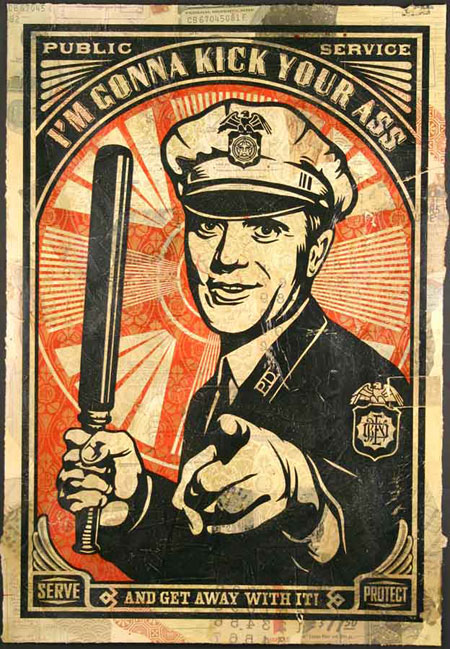A Denver-area high school student’s painting depicting a police officer as a Ku Klux Klan member will be removed from a public building following criticism by local police, WestWord reported. The painting had been on display at the Wellington Webb Municipal Office Building as part of an art show mounted by the Denver Public Schools system. It showed the officer pointing a gun at a black child wearing a hooded sweater with their hands up. The backdrop shows the Confederate flag laid under the American flag…. “I’m greatly concerned about how this painting portrays the police,” said Police Chief Robert White. “I look forward to having a conversation with the student and her parents.”
 It’s been said that the first step to solving a problem is recognizing that you have one. Denial makes it difficult if not impossible to recognize, much less improve a situation. Despite that, the Denver Police Department seems to have adopted denial of a patently obvious problem as their primary PR strategy.
It’s been said that the first step to solving a problem is recognizing that you have one. Denial makes it difficult if not impossible to recognize, much less improve a situation. Despite that, the Denver Police Department seems to have adopted denial of a patently obvious problem as their primary PR strategy.
DPD could have interpreted the painting as an expression of the gulf between law enforcement and those it’s supposed to protect and serve. What seems to be forgotten- as evidenced by the full-throated condemnation of the painting- is that the role of the police is to PROTECT and SERVE the public. Instead of seeing in the painting an opportunity to honestly assess their relationship with the community, DPD has chosen to shoot (I know; probably a poor choice of words) the messenger.
The cultural context of this story alone is worth examination. DPD’s number of officer-involved shootings reached a 15-year high in 2015. To most reasonable sorts, this would seem to present an opportunity to address the widespread perception that police are the instruments of official oppression. They aren’t, of course, but perception is everything. Given all that’s happened over the past year or so- Ferguson, Baltimore, Cleveland, etc., etc., ad infinitum, as nauseum- taxpayers should be able to expect that law enforcement would redouble efforts to reach out to the communities they serve.
Instead, what we get is righteous, voluble outrage and butthurt. How DARE a child create a painting that illustrates the disconnect between police and the community? What gives a young artist the right to express themselves and impugn those who put their lives on the line every single day? Why does everyone hate us??
Well, if the police aren’t listening- and they certainly don’t seem to be- what other choice is left? Perhaps it’s time for them to be reminded that they serve the public- not the other way around.
The painting was reportedly described as “Re-Contextualization of Goya’s Third of May,” a reference to Francisco Moya’s acclaimed work The Third of May, 1808, which depicts French troops aiming their weapons at a man — described as a Spanish “poor laborer” — during Spain’s rebellion against French control.
It is also reportedly infuenced by Michael D’Antuono’s 2014 work A Tale of Two Hoodies, which shows a Klan member aiming their gun at a black youth in a hooded sweater offering them a bag of Skittles candy — a clear reference to the shooting death of Trayvon Martin at the hands of George Zimmerman.
Regardless of the perceived artistic or social merit of the painting, it represents a perception that police are the enemy of Denver’s African-American community. Nationwide, it’s a similar story, with young African-Americans far more likely than any other demographic to be shot by police. The reality and the perception are problems that need to be addressed- by police and the community at large.
The reaction of DPD, as well as the National Latino Peace Officers Association and the Denver Police Protective Association, demonstrates that police see themselves as the real victims. As much as I respect law enforcement for the difficult and dangerous job they do, carrying a badge doesn’t come with the right to assume victimhood when things go bad. The collective police outrage over the painting illustrates why the African-American community feels victimized. The question of their right to that victimhood is a discussion best left for another time, but the African-African community has seen too many examples of what can happen to someone stopped by police for Breathing While Black. That the community feels they have a legitimate grievance means that police have a responsibility meet them halfway and address that grievance.
Police don’t get to claim to be the victims when they’re the ones responsible for the violence that’s created the rift with the African-American community. If they’re upset by a young artist’s painting, perhaps they’d be well-advised to take a step back and consider why that could be the case. No one owes law enforcement an apology for expressing their anger and displeasure, and police should be able to be professional and human enough to examine the realities behind that expression.
Being young, Black, and male shouldn’t mean one is at greater risk of being assaulted or killed by the very same law enforcement personnel charged with protecting them. There’s a very real problem- in Denver and elsewhere. It’s time police took a good long look at what they’re doing and why.

